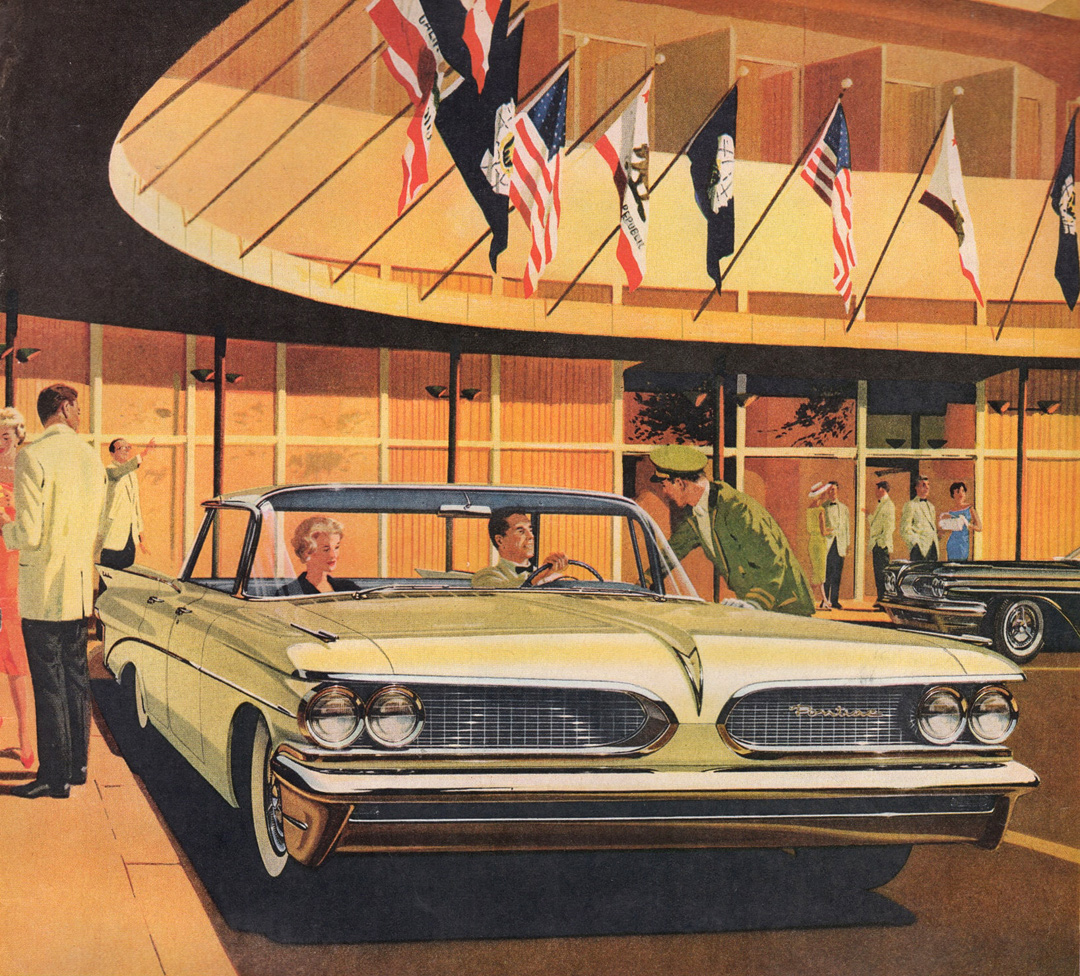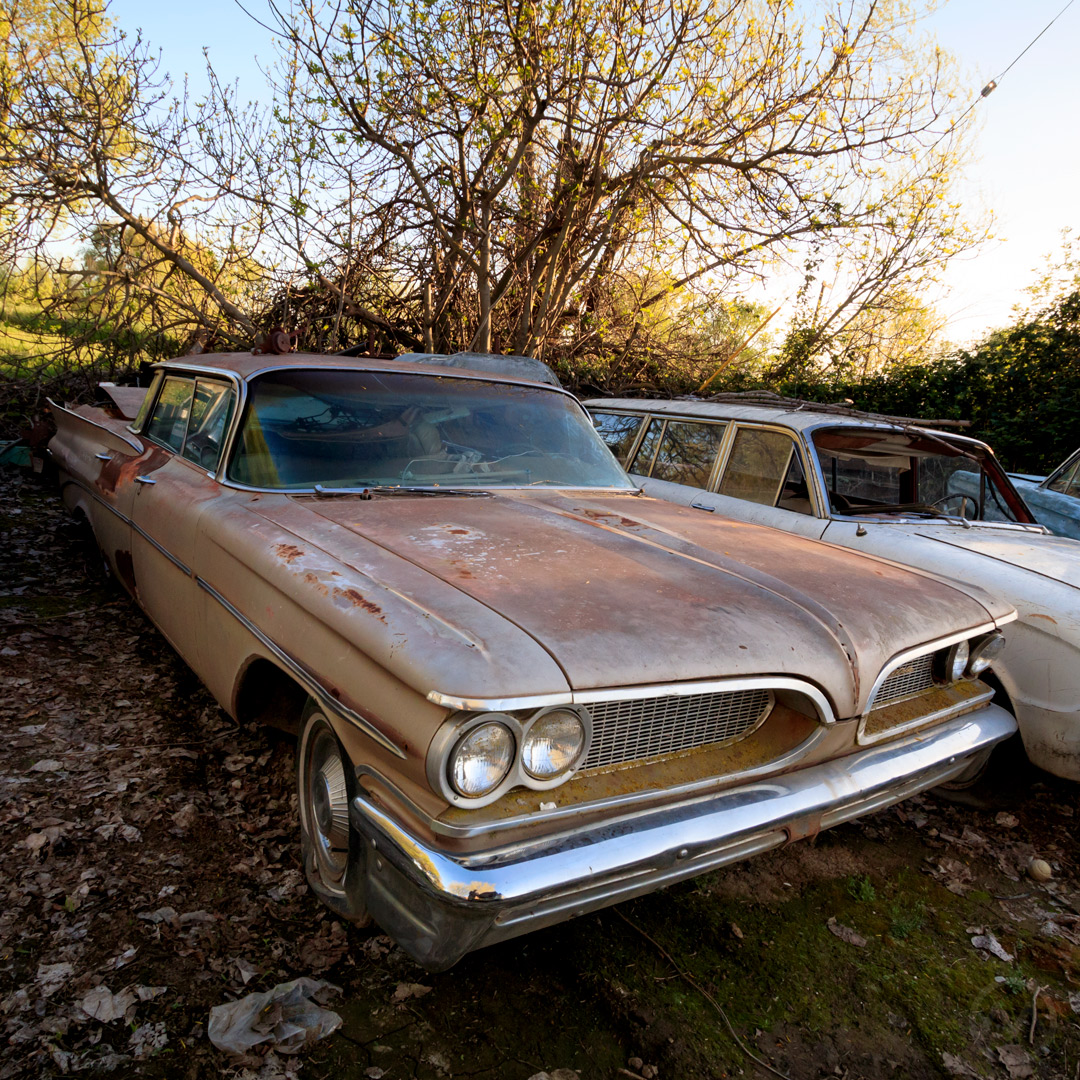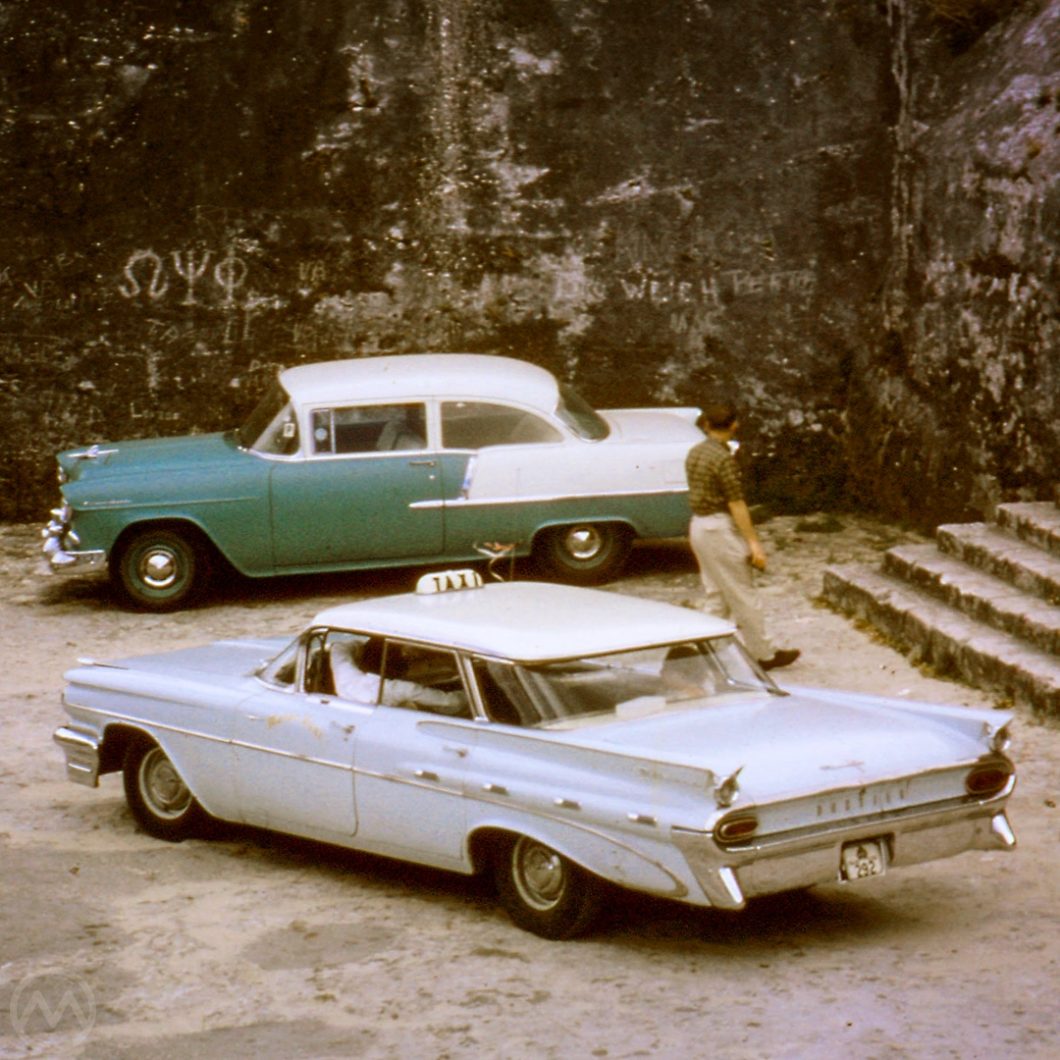For today’s Flashback we’re visiting Fort Charlotte in the Bahamas today, courtesy of this 1959 Pontiac Parisienne Vista taxi. Cabbies sometimes luck out and get the best rides.
Fort Charlotte was built from 1789 to 1819 by the British Army as a way of keeping a wary eye on the recently-independent Americans and aggressive Spanish intruders. It never saw any combat, though more than a few illegal pirate ship operators may have ended up there. It’s a popular tourist destination to this day, but this photo dates from the early 1960s.
We don’t usually think of the 1959 Pontiac as the kind of car that would have been a cab, and taxi duty was usually reserved for the bottom-end Catalina sedan, not the swanky Star Chief, Parisienne, or Bonneville Vistas.
Cabs in places like Nassau at that time tended to be whatever was handy, affordable, and well-suited to the job. You could hardly ask for better for a tourist taxi: that expansive Vista roof, huge interior, and massive trunk.
1959 marked the arrival of the famous “wide track” era at Pontiac, which wasn’t as amazing for handling as the advertising made it out to be, but which certainly looked amazing and did give the cars a slight handling advantage – or at least some of them. It resulted in Pontiac’s best year in a long time, and the start of more than a decade of huge success at Pontiac.
But not every Pontiac actually had a “wide” track. In Canada it was Pontiac, not Chevrolet, that was the standard bearer for GM. Pontiac had a much larger network of dealers “north of the border,” and local assembly of the vehicles resulted in a hybrid of Pontiac bodies and styling and Chevrolet mechanical components starting in 1955.
Before 1955, it was almost impossible see much of a difference between the Canadian Pontiacs and their American cousins despite some subtle styling tweaks, but the “wide track” made the visual distinction a little more apparent, because the wheels were 3 inches further inward on the Chevy chassis.
Pontiac’s Revolution
Pontiac had been floundering for years under conservative management. There had been a false start at reinventing the division in the early 50s with new GM Arnold Lenz and engineer George Delaney worked on a plan for a new V8 and new styling. But when Lenz was killed in a car accident in the summer of 1952, that vision was derailed, though the V8 emerged in 1955.
Real change didn’t happen until the old Silver Streaks, au courant in the 1930s but old fashioned 20 years later, were pried off by new general manager Semon “Bunkie” Knudsen, who brought in engineer Pete Estes from Oldsmobile and eventually John DeLorean as well.
They set about reinventing Pontiac as the “Excitement” division – inheriting the performance mantle that Oldsmobile had essentially abdicated a few years earlier. But 1958, the first year that they were able to really change the cars, was a sales disaster thanks to the Eisenhower recession.
Originally, the ‘59 models were to have been facelifted ‘58s, but when GM’s design staff got a look at the new ‘57 Chrysler “forward look” cars in the late summer of 1956, new style boss Bill Mitchell instituted a crash program to redesign all the ‘59s.
Mitchell was in the process of taking over for the soon-to-retire Harley Earl at the time, and Earl’s ‘58s were largely unloved – too much chrome ornamentation, though some of them look very nice in hindsight, including the interstellar-themed Pontiac. Buyers didn’t really love them at the time though, and the ‘59s would be all new.
Because of the limited time frame, many 1959 GM cars had to share lots of components, much more so than was historically normal.
Bud Sugano’s Flying Wing
Although it’s the coupes, convertibles, and massive fins that get most of the attention today, one of the most striking new parts of the ‘59s was the “flying wing” flat-top roof. At Pontiac, this treatment was called the “Vista” hardtop, but it could be seen on all five car divisions.
This design was created by Japanese-American Masaji “Bud” Sugano, one of the very first Asian-American car designers. Sugano trained at the Art Center College of Design after WW2, where he’d served in the army as a translator while his parents sat in an internment camp. He joined GM in 1951, hired by Harley Earl.
Sugano had a long career at GM designing many projects (not all cars), though he wasn’t always treated respectfully there in the 1950s. By the early 1960s there were a whole group of Nisei designers at GM including Philip Ishimaru, who left to go into architecture, Larry Shinoda who would later move to Ford, and a few others.

Sugano came up with the “flying wing” idea and then worked with designer Carl Renner to adapt it for production – but it wasn’t necessarily intended to be used on the entire line.
The flat-top styling and wraparound rear window made for an amazingly airy, bright interior and it looked fast, but the regular sedans proved more popular.
Wide Vs. Narrow Tracks
The flat-top look remained on many GM offerings into 1962, but faded away thereafter. The “wide track” came courtesy of Chuck Jordan’s advance studio, who moved the wheels outward to the delight of Knudsen and Estes, who liked the athletic stance.
The wide stance made the Pontiac look even lower and sleeker than it already was – and 1959 was the epitome of the “longer, lower, wider” school of thinking.
The dramatic split grill front, soon to be a Pontiac trademark, is of disputed origin. GM legend Dave Holls claimed Paul Gillian, the outgoing Pontiac style boss, created it. Jack Humbert, who replaced Gillian in 1959, later said it was staffer Joe Schemansky. Either way, the ‘59 was a stunner, visually.
Knudsen didn’t really like the “wide track” slogan, coined by advertising writer Milt Colson at Pontiac’s ad agency, MacManus, John & Adams, but he did like the sales results. Pontiac built 383,000 U.S. cars in 1959, up from 217,000 in ‘58, and never looked back.

The “wide track” gave the car slightly better handling, which the advertising talked up almost endlessly – but the ‘59 Pontiac was still a floaty boulevardier by international standards. The cars were tuned more a soft and comfy ride than corner carving.
That really didn’t matter as much as straight line speed, and there Pontiac delivered. All U.S. Pontiacs were 389 V8s, some up to a 330 hp Tri-power, but of course in Canada things were different.
A Parisienne in the Bahamas
Before the 1965’s Canada—United States Automotive Products Agreement (AKA APTA or the “Auto Pact”), significant trade tariffs kept Canadian-built cars like the Parisienne out of the United States and vice-versa.
Canada had a long established if relatively small car industry that essentially existed as a satellite operation of Detroit’s Big Three. It was mostly concentrated in Ontario on the long corridor between Windsor (just over the river from Detroit) and Oshawa, northeast of Toronto.
Car components were relatively easy to import in either direction but this resulted in a huge trade deficit for Canada. Because Canada was a relatively small market in terms of population, cars were relatively expensive there – but as part of the Commonwealth trade was relatively free to other Commonwealth countries.
In Australia, “American” imported cars were almost universally built in Canada for that reason. The Bahamaian car market, much smaller than Australia’s was another destination for Canada’s exports, and Pontiacs were both shipped and sent in CKD (“Complete Knock-Down”) form to the Islands.
There were three lines of Canadian Pontiacs – the base-model Strato Chief, the mid-level Laurentian, and the flagship Parisienne. Externally, the way to tell them apart from U.S. models was the taillights, badges and trim – and also the narrower track for 1959.
All of the Canadian cars used the smaller and narrower Chevrolet X-frame and Chevrolet engines and running gear. These items were produced in much larger quantities than those of the U.S. domestic Pontiacs, and therefore the unit cost was much lower. As is often the case, what gets built is what’s most cost-effective to build.
As a result, this most prominent of “wide track” years actually didn’t have a wider track at all in Canada or any of the places Canadian Pontiacs were exported.
The Auto Pact of 1965 put an end to the trade tariffs, and within a few years cars flowed freely between the U.S. and Canada. The Big Three made major investments in Canada which offset U.S. production costs and lowered Canadian car prices significantly. But the old-way Parisienne and other Pontiacs continued for a long time.
The Parisienne and Laurentian continued to use Chevrolet bits into the 1980s, though there became fewer distinctions in the 1970s as corporate component sharing became the norm at GM. The Parisienne finally did come stateside in 1983, but by then the “wide track” era was long over.


Would it be possible to list how many Factory The Air Ride Pontiac’s were made in Canada
Bud Sugano was my dad and I am very proud of his accomplishments although working at the tech center did seem like he was a secret agent. Everything was hush hush. I did get a little bit that anti Asian sentiment he was treated with as he was very humble and dedicated his talent professionally to GM.